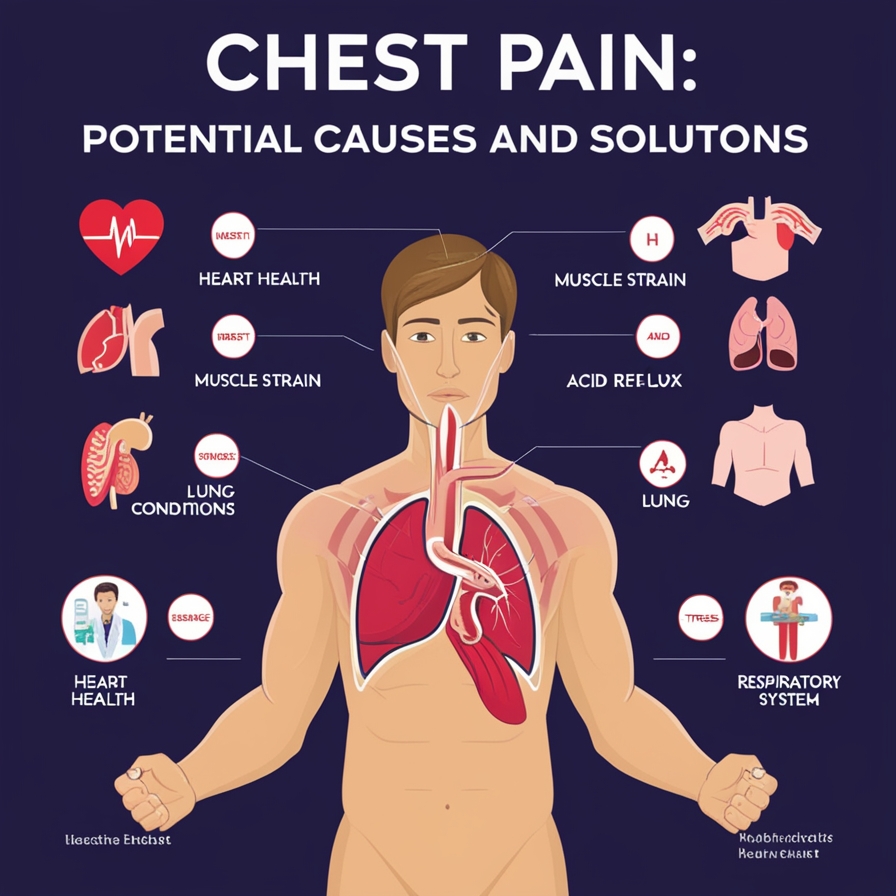Chest pain is a common complaint that can stem from a wide variety of causes, It can range from mild discomfort to severe, life-threatening conditions, Understanding the potential causes and solutions can help individuals make informed decisions about when to seek medical attention and how to address the issue.
Understanding Chest Pain
Chest pain is not a condition in itself but a symptom of an underlying problem, It can manifest in different forms, such as sharp, dull, burning, or squeezing sensations, the pain may be localized to the chest or radiate to other areas, such as the neck, arms, jaw, or back.
Potential Causes of Chest Pain
Chest pain can result from various conditions, broadly categorized into cardiac and non-cardiac causes.
Cardiac Causes
Heart Attack (Myocardial Infarction)
A heart attack occurs when blood flow to a part of the heart is blocked, usually by a blood clot.
Symptoms include intense pressure or squeezing in the chest, shortness of breath, nausea, and pain radiating to other parts of the body.
Angina.
Angina is chest pain due to reduced blood flow to the heart muscles, often triggered by physical exertion or stress.
It typically subsides with rest or medication.
Pericarditis.
Inflammation of the pericardium (the sac surrounding the heart) can cause sharp chest pain that worsens when lying down or taking deep breaths.
Aortic Dissection.
A tear in the wall of the aorta can cause sudden, severe chest pain that may radiate to the back.
This is a medical emergency requiring immediate attention.
Non-Cardiac Causes
Gastroesophageal Reflux Disease (GERD)
Acid reflux can cause a burning sensation in the chest, often mistaken for heart-related pain.
Musculoskeletal Issues.
Strained chest muscles or costochondritis (inflammation of cartilage in the ribcage) can lead to localized pain.
Lung Conditions.
Conditions such as pneumonia, pulmonary embolism, or pleuritis can cause chest pain accompanied by coughing, shortness of breath, or fever.
Panic Attacks.
Intense anxiety or panic attacks can mimic heart attack symptoms, including chest pain, rapid heartbeat, and sweating.
Shingles.
This viral infection can cause severe, localized chest pain if it affects nerves in the chest area.
When to Seek Medical Attention
Chest pain should never be ignored, especially if it is.
Sudden and severe
Accompanied by shortness of breath, dizziness, or fainting
Radiating to other parts of the body, such as the arms or jaw
Associated with nausea, sweating, or a sense of impending doom
In such cases, immediate medical evaluation is crucial.
Solutions and Management
The treatment for chest pain depends on the underlying cause.
Cardiac Causes.
Heart attacks and other cardiac conditions require emergency care, treatment may include medications, angioplasty, or surgery.
Long-term management involves lifestyle changes, such as a heart healthy diet, regular exercise, and medications to control blood pressure and cholesterol.
GERD.
Lifestyle modifications like avoiding trigger foods, eating smaller meals, and not lying down after eating can help.
Medications such as antacids, H2 blockers, or proton pump inhibitors may be prescribed.
Musculoskeletal Issues.
Rest, ice packs, and over-the-counter pain relievers can alleviate symptoms.
Physical therapy may be recommended for persistent pain.
Lung Conditions.
Antibiotics, anticoagulants, or anti-inflammatory medications may be necessary, depending on the condition.
Panic Attacks.
Techniques like deep breathing, mindfulness, and therapy can help manage anxiety-related chest pain.
Medications may be prescribed in severe cases.
Shingles.
Antiviral medications and pain relievers can help reduce symptoms and prevent complications.
Preventing Chest Pain
Preventive measures depend on the specific cause but generally include.
Maintaining a healthy lifestyle with a balanced diet and regular exercise
Avoiding smoking and excessive alcohol consumption
Managing stress through relaxation techniques
Regular medical check ups to monitor and manage risk factors like hypertension, diabetes, and high cholesterol
Conclusion
Chest pain is a symptom that should always be taken seriously, while not all chest pain is life threatening, distinguishing between benign and serious causes is essential, prompt medical attention and appropriate treatment can save lives and improve outcomes, by adopting a proactive approach to health and understanding the potential causes of chest pain, individuals can take meaningful steps to safeguard their well-being.

